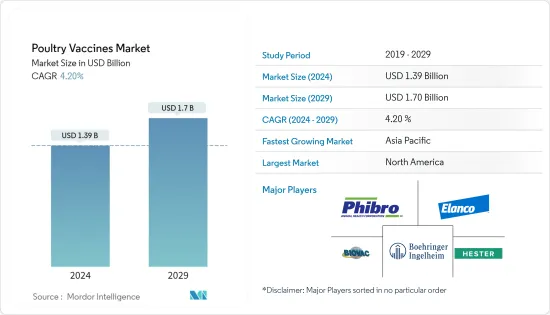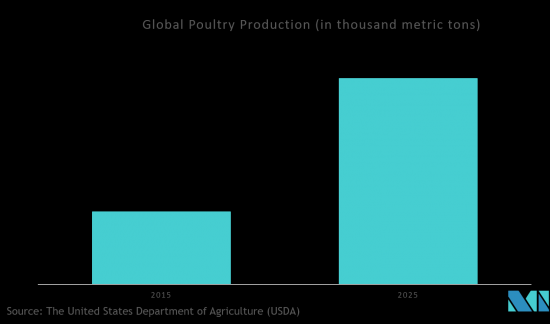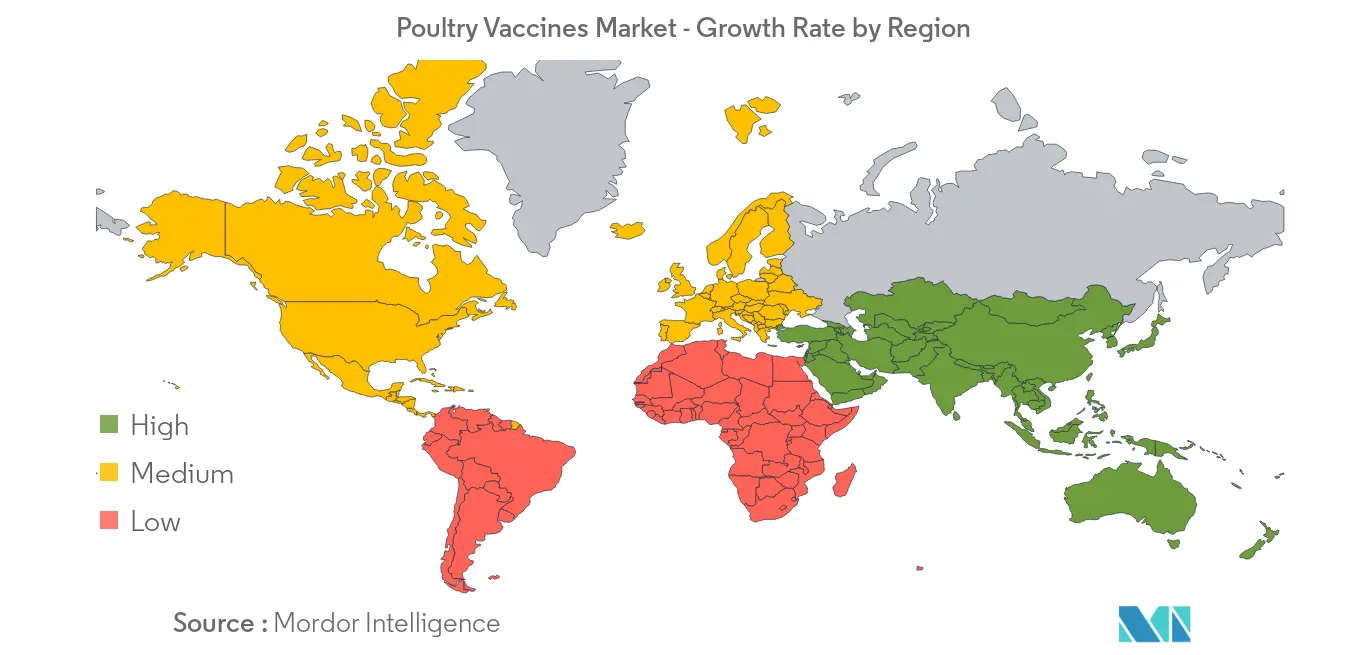
|
시장보고서
상품코드
1430004
가금용 백신 : 시장 점유율 분석, 산업 동향 및 통계, 성장 예측(2024-2029년)Poultry Vaccines - Market Share Analysis, Industry Trends & Statistics, Growth Forecasts (2024 - 2029) |
||||||
가금용 백신 시장 규모는 2024년에 13억 9,000만 달러로 추정되고, 2029년에는 17억 달러에 이를 것으로 예측되며, 예측 기간 중(2024-2029년) CAGR 4.20%로 성장할 전망입니다.

이 성장의 주요 요인은 가금두수 증가 및 가금류의 인수 공통 감염의 유행 증가와 함께 가금의 건강에 대한 수요가 높아지고 있다는 것입니다. 게다가 세계의 식육 소비량 증가, 정부의 이니셔티브, 가금 관련 식품 수요 증가, 새로운 백신 제조를 위한 최신 기술, 가금 의료비 증가가 세계의 가금용 백신 시장의 성장을 가속하고 있는 요인입니다.
가금용 백신 시장 동향
조류독감이 시장을 선도할 전망
조류 독감은 세계 모든 국가에서 발견되는 바이러스성 질환으로 조류에서 발생합니다. 중증도는 경도에서 중도까지 다양합니다. 조류 독감은 직접 접촉하여 사람을 감염시킵니다. 미국, 아시아, 유럽 등 국가에서 질병 발생이 보고되었습니다.
백신은 세계 동물보건기구(WHO)가 정한 기준을 클리어한 것만이 승인됩니다. 조류 인플루엔자 백신은 헤마글루티닌(HA) 단백질에 대한 방어를 받기 위해 접종됩니다.
세계보건기구(WHO)에 따르면 2020년 3월 27일 대만에서 OIE로 새 사이에 고병원성 조류 인플루엔자(HPAI) A(H5N2)의 새로운 발생이 2건 보고되었습니다. 발생은 유린 카운티의 두 마을에서 발생했습니다. 확인된 9,578마리의 민감한 새들 중 1,819마리가 사망했고 나머지 7,759마리는 사멸되었습니다.
또한 CDC는 이 질병의 사망률이 약 90%에서 100%로 보고했습니다. 이것은 이 질병이 높은 위험을 동반한다는 것을 보여줍니다. 따라서 규제기관은 현재 수의 위생과 관련된 다양한 백신의 승인 과정을 가속화하고 있습니다.

예측기간 중 북미가 우위를 차지할 전망
예측 기간 동안 북미의 가금용 백신은 세계 시장에서 큰 점유율을 차지할 것으로 예상되지만, 이는 가금 유래 제품의 소비량 증가, 음식 안전에 대한 소비자 의식 증가, 가금 관련 인수공통 감염의 발생률 증가와 같은 요인 때문입니다.
미국 농무부(USDA)가 발표한 데이터에 따르면 2016년 닭고기 제품의 1인당 소비량은 107.6파운드로, 2017년에는 108.6파운드로 증가했습니다. 또한 유엔 식량농업기관(UNFAO)이 발표한 통계에 따르면 이 지역에서는 계란과 닭 생산량이 증가하고 있습니다. 미국의 동물용 백신은 동식물 검역국(APHIS)의 동물용 생물 제제 센터(CVB)에 의해 규제됩니다. CVB는 동물용 생물 제제를 제조 및 판매하기 위해 동물 의약품 회사에 설립 및 제품 승인을 제공합니다.
또 북미에서는 백신 개발에 있어서의 진보로서 생 벡터 백신, 비복제 재조합 항원 백신, 핵산 매개 백신, 생유전자 제거 백신의 개발을 들 수 있습니다. 이것은 예측 기간 동안 시장 성장을 가속할 것으로 보입니다.

가금용 백신 산업 개요
가금용 백신 시장의 기업은 시장에서의 존재감을 높이기 위해 제휴, 파트너십, 계약 및 M&A 등 다양한 성장 전략을 추진하고 있습니다. 주요 진출기업은 Bio-Vet, Boehringer Ingelheim, Ceva Animal Health, Elanco, Merck & Co., Fibro Animal Health Corporation, Venkys, Zoetis Inc. 등입니다.
기타 혜택 :
- 엑셀 형식 시장 예측(ME) 시트
- 3개월간의 애널리스트 서포트
목차
제1장 서론
- 조사의 성과
- 조사의 전제
- 조사 범위
제2장 조사 방법
제3장 주요 요약
제4장 시장 역학
- 시장 개요
- 시장 성장 촉진요인
- 가금류 및 인수공통 감염증 증가
- 식품 안전에 대한 주목의 고조
- 시장 성장 억제요인
- 위조 의약품의 사용
- 동물 검사 및 수의 서비스 비용 증가
- Porter's Five Forces 분석
- 신규 참가업체의 위협
- 구매자 및 소비자의 협상력
- 공급기업의 협상력
- 대체품의 위협
- 경쟁 기업간 경쟁 관계의 강도
제5장 시장 세분화
- 질병별
- 기관지염
- 조류 인플루엔자
- 뉴캐슬병
- 말렉병
- 기타
- 기술별
- 재조합 백신
- 불활성화 백신
- 생백신(LAV)
- 기타
- 지역별
- 북미
- 미국
- 캐나다
- 멕시코
- 유럽
- 독일
- 영국
- 프랑스
- 이탈리아
- 스페인
- 기타 유럽
- 아시아태평양
- 중국
- 일본
- 인도
- 호주
- 한국
- 기타 아시아태평양
- 중동 및 아프리카
- GCC
- 남아프리카
- 기타 중동 및 아프리카
- 남미
- 브라질
- 아르헨티나
- 기타 남미
- 북미
제6장 경쟁 구도
- 기업 프로파일
- Biovac
- Boehringer Ingelheim International GmbH
- Ceva Sante Animale
- Dechra Pharmaceuticals PLC
- Elanco
- Hester Biosciences Limited
- Merck & Co., Inc.
- Phibro Animal Health Corporation
- Venky's Limited
- Zoetis Inc.
제7장 시장 기회 및 앞으로의 동향
AJY 24.02.28The Poultry Vaccines Market size is estimated at USD 1.39 billion in 2024, and is expected to reach USD 1.7 billion by 2029, growing at a CAGR of 4.20% during the forecast period (2024-2029).

The growth is primarily attributed to rising demand for the poultry health coupled with the increasing poultry headcount and increasing prevalence of zoonotic diseases in poultry. Furthermore, the growing consumption of meat globally, initiatives are taken by the government, growing demand for poultry-related food products, latest technologies for manufacturing new vaccines and the increasing poultry healthcare expenditure are the factors that are fueling the growth of the global poultry vaccines market.
Poultry Vaccines Market Trends
Avian influenza is Expected to Lead the Market
Avian influenza is a viral disease which is found across all the countries in the world and occurs in birds. The severity of the disease can vary from mild to severe. Avian influenza is transmitted to human beings by direct contact. Disease outbreaks have been reported in countries, such as the United States, Asia, and Europe.
The vaccines are approved only if they pass the standards set by the World Organization for Animal Health. The vaccine for the avian influenza is given to imbibe the protection against hemagglutinin (HA) protein.
According to toWorld Health Organization, On 27 March 2020, two new outbreaks of highly pathogenic avian influenza (HPAI) A(H5N2) among birds were reported to OIE from Taiwan, China. The outbreaks occurred in two townships in Yunlin county. Among 9,578 susceptible birds identified, there were 1,819 deaths and the remaining 7,759 poultry were culled.
Furthermore, the CDC has reported that the mortality for this disease is around 90%-100%. This shows that the disease is associated with the high risk. Hence, the regulatory bodies are now accelerating the process of approval for various vaccines related to the veterinary health.

North America is expected to dominate over the Forecast Period
North America poultry vaccine is expected to have a significant share in the worldwide market over the forecast period, owing to the factors, such as the increase in consumption of poultry-derived products, growing consumer awareness regarding food safety, and increasing incidence of zoonotic diseases associated with poultry.
According to the data published by the US department of agriculture (USDA), the per capita consumption of poultry products in 2016 was 107.6 pounds and was increased to 108.6 pounds in 2017. Furthermore, there is an increase in the production of eggs and hen in the region, as per the statistics published by the UNFAO. Veterinary Vaccines in the United States is regulated by the Center for Veterinary Biologics (CVB) in the Animal and Plant Health Inspection Service (APHIS). The CVB grants establishment and product license to animal health companies, to manufacture and sell veterinary biologics.
Also, in North America advancements in vaccines development include the development of live vector vaccines, non-replicating recombinant antigen vaccines, nucleic acid-mediated vaccines, and live-gene-deleted vaccines. This is likely to fuel the market growth over forecast period.

Poultry Vaccines Industry Overview
The market players in the poultry vaccines market are involving in various growth strategies such as collaborations, partnerships, agreements, mergers and acquisitions in order to enhance the market presence. Few key players in the market are Bio-Vet, Boehringer Ingelheim, Ceva Animal Health, Elanco, Merck & Co., Phibro Animal Health Corporation, Venkys, and Zoetis Inc.
Additional Benefits:
- The market estimate (ME) sheet in Excel format
- 3 months of analyst support
TABLE OF CONTENTS
1 INTRODUCTION
- 1.1 Study Deliverables
- 1.2 Study Assumptions
- 1.3 Scope of the Study
2 RESEARCH METHODOLOGY
3 EXECUTIVE SUMMARY
4 MARKET DYNAMICS
- 4.1 Market Overview
- 4.2 Market Drivers
- 4.2.1 Increasing Incidences of Poultry and Zoonotic Diseases
- 4.2.2 Widened Focus on Food Safety
- 4.3 Market Restraints
- 4.3.1 Use of Counterfeit Medicine
- 4.3.2 Increasing Costs of Animal Testing and Veterinary Services
- 4.4 Porter's Five Force Analysis
- 4.4.1 Threat of New Entrants
- 4.4.2 Bargaining Power of Buyers/Consumers
- 4.4.3 Bargaining Power of Suppliers
- 4.4.4 Threat of Substitute Products
- 4.4.5 Intensity of Competitive Rivalry
5 MARKET SEGMENTATION
- 5.1 By Disease
- 5.1.1 Bronchitis
- 5.1.2 Avian Influenza
- 5.1.3 Newcastle disease
- 5.1.4 Marek's Disease
- 5.1.5 Others
- 5.2 By Technology
- 5.2.1 Recombinant Vaccines
- 5.2.2 Inactivated Vaccines
- 5.2.3 Live Attenuated Vaccines (LAV)
- 5.2.4 Others
- 5.3 Geography
- 5.3.1 North America
- 5.3.1.1 United States
- 5.3.1.2 Canada
- 5.3.1.3 Mexico
- 5.3.2 Europe
- 5.3.2.1 Germany
- 5.3.2.2 United Kingdom
- 5.3.2.3 France
- 5.3.2.4 Italy
- 5.3.2.5 Spain
- 5.3.2.6 Rest of Europe
- 5.3.3 Asia Pacific
- 5.3.3.1 China
- 5.3.3.2 Japan
- 5.3.3.3 India
- 5.3.3.4 Australia
- 5.3.3.5 South Korea
- 5.3.3.6 Rest of Asia-Pacific
- 5.3.4 Middle East and Africa
- 5.3.4.1 GCC
- 5.3.4.2 South Africa
- 5.3.4.3 Rest of Middle East and Africa
- 5.3.5 South America
- 5.3.5.1 Brazil
- 5.3.5.2 Argentina
- 5.3.5.3 Rest of South America
- 5.3.1 North America
6 COMPETITIVE LANDSCAPE
- 6.1 Company Profiles
- 6.1.1 Biovac
- 6.1.2 Boehringer Ingelheim International GmbH
- 6.1.3 Ceva Sante Animale
- 6.1.4 Dechra Pharmaceuticals PLC
- 6.1.5 Elanco
- 6.1.6 Hester Biosciences Limited
- 6.1.7 Merck & Co., Inc.
- 6.1.8 Phibro Animal Health Corporation
- 6.1.9 Venky's Limited
- 6.1.10 Zoetis Inc.

















